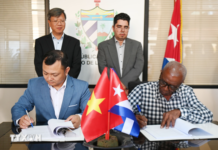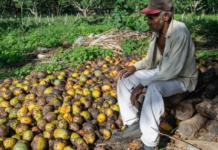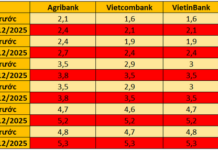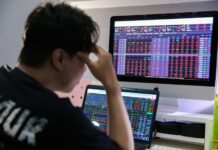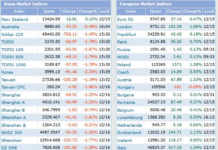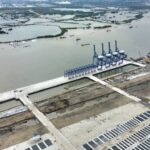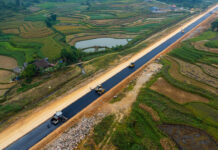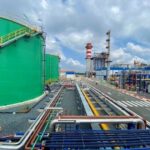
Prime Minister Pham Minh Chinh speaking at the conference on December 2nd. Photo: VGP
|
According to the Prime Minister, amidst the region’s slowing growth trend, localities must strive for a 7% growth rate this year and expedite the disbursement of public investment capital. The region’s industrial index has rebounded, but it needs to be more sustainable.
Regarding the 2025 plan, the Prime Minister requested that the provinces and cities in the region prioritize economic growth and aim for a double-digit increase. The solution lies in continuing to improve the institutional framework, focusing on disbursing public investment capital, making breakthroughs in exports, and stimulating consumption.
For the Ring Road 4 project, the Government leader continues to assign Ho Chi Minh City as the investment management agency, dividing the project into components, and in the first quarter of 2025, the project must be approved and submitted to the National Assembly for mechanisms and policies.
Regarding the Can Gio International Port project, the Prime Minister assigned the Ministry of Transport and the Ministry of Planning and Investment to complete the procedures this year to resolve it conclusively in December. Concerning the construction of a free trade area and an offshore wind power center, the Prime Minister suggested that Ba Ria-Vung Tau province proactively coordinate with the Ministry of Planning and Investment and the Ministry of Industry and Trade to implement the necessary procedures.
According to the Ministry of Planning and Investment, this year’s estimated economic growth rate for the Southeast region is 6.38%, lower than the national average (6.8-7%), ranking fourth among six economic regions. The region’s GRDP scale reached more than 3,565 trillion VND, and the per capita income was estimated at over 187 million VND/year, leading the country’s economic regions and higher than the national average.
Total state budget revenue is estimated at 733 trillion VND (accounting for about 42.2% of the country). Of which, domestic revenue is over 492 trillion VND, up 2.9% compared to the assigned estimate. Export turnover is estimated at over $115 billion, accounting for 31% of the country’s total export turnover.
The region continues to lead the country in the number of projects and total foreign direct investment – as of October 31, with 21,174 projects and over $189 billion. Ho Chi Minh City leads the country in terms of the number of projects, accounting for nearly 32.2%, and 12% of the total registered capital. In terms of public investment disbursement, by the end of October, the region’s disbursement rate was 36.1%, lower than the national average of over 54.7%.
However, the Southeast region is facing challenges such as traffic congestion, flooding, and inadequate infrastructure, while there is still untapped potential and advantages. Notably, the lack of connectivity between ports and the absence of a diverse logistics ecosystem in the Southeast region hinder the efficient flow of goods in the region.
To achieve the targets set by the Prime Minister, Minister of Planning and Investment Nguyen Chi Dung proposed that localities closely follow the new context and situation to accelerate the completion of next year’s plan. The region needs to focus on completing key infrastructure systems, connecting expressways with airports and seaports, completing the Long Thanh International Airport, investing in the Can Gio International Port, and completing the Bien Hoa-Vung Tau expressway…
Localities also need to remove obstacles in projects and works that are stagnant, causing land and investment resources to be wasted; restructure the industry to create breakthroughs; and attract investment in emerging industries such as chip manufacturing, AI, green economy, and circular economy…
|
The Southeast region comprises six provinces and cities: Ho Chi Minh City, Dong Nai, Binh Duong, Ba Ria-Vung Tau, Binh Phuoc, and Tay Ninh, with a total area of over 23,560 km2 and a population of over 18.7 million people (as of 2021). This region consistently maintains one of the highest economic growth rates in the country, contributing more than 30% to Vietnam’s GDP. |
The Vietnamese Economy: Banking on Success
Dr. Nguyen Tu Anh, Director of the Information, Analysis, and Economic Forecasting Center at the Central Economic Commission, asserts that Vietnam’s economy remains heavily reliant on the banking sector. He emphasizes, “We must develop other key capital markets. As the capital market grows and becomes more diversified, the economy will also experience new vibrancy.”
Proposed Free Trade Zone in Long Thanh Airport Urban Area
The Dong Nai Province has proposed the establishment of a free trade area within the Long Thanh International Airport urban area and its vicinity to maximize the potential and development advantages of the airport. This strategic initiative aims to create a vibrant economic zone, leveraging the airport’s infrastructure and connectivity to attract foreign investment, boost trade, and stimulate economic growth in the region. With its convenient location and world-class facilities, the Long Thanh International Airport is poised to become a pivotal aviation hub, and the proposed free trade area will further enhance its significance, creating a thriving epicenter of commerce and trade.
Unveiling the Champion of GRDP Growth in 2024: Three Years of Consecutive Leadership, Surpassing the 200,000 Billion Dong Milestone
Recently, the People’s Committee of Bac Giang province held its 11th periodic conference for 2024. Speaking at the event, Mr. Mai Son, Acting Chairman of the Provincial People’s Committee, emphasized that in 2024, with the unity, consensus, and resilience of the people and businesses, the province’s socio-economic development continued to yield positive results.

